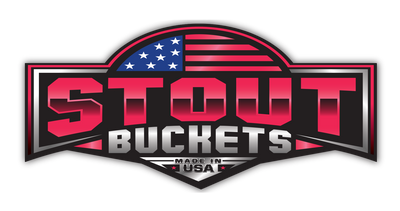Replacing the Hydraulic Cylinder on a Skid Steer Grapple

Skid steer operators understand that maintenance isn’t just about keeping a machine running; it’s about guaranteeing the machine operates at peak performance. Every skid steer attachment comes with its own maintenance requirements, including general repairs.
Stout Buckets is here to guide you through replacing the hydraulic cylinder on a skid steer grapple. Continue reading to learn the signs of damage, the specific replacement steps, and how to ensure the skid steer grapple functions properly. The more you know about this process, the easier it is to maintain this machine in the long run.
Recognize the Signs of a Failing Hydraulic Cylinder
Before jumping into the replacement process, it’s a good idea to identify if your hydraulic cylinder needs attention. Common signs of a failing cylinder include:
- leaks around the piston rod or base,
- reduced lifting power or slow operation,
- peculiar sounds coming from the attachment,
- and visible damage or wear on the cylinder.
If you notice any of these symptoms, you want to take action as soon as possible. Ignoring them can lead to more significant issues and higher repair costs.
Prepare for the Replacement
Before you start trying to repair your grapple bucket, you should gather all the necessary tools and parts. Here’s a helpful list of what you will need during your maintenance:
- the replacement hydraulic cylinder
- a set of wrenches and sockets
- hydraulic fluid
- safety gear, including gloves and goggles
- a clean work area to lay out parts
With protective gear and all your tools in place, the next part is to park the skid steer on a level surface. Then, turn off the engine. Take the time to relieve all the pressure in the hydraulic system by moving the controls into a neutral position. This action prevents accidental movement during the replacement.

Remove the Old Cylinder
The first step to replace the hydraulic cylinder on a skid steer grapple is to remove the old one. Follow these instructions to successfully take the previous cylinder off the skid steer:
- Locate the hydraulic cylinder on the grapple. Inspect it for mounting bolts and hydraulic lines.
- Carefully disconnect the hydraulic lines using a wrench. You should place a container beneath the hydraulic lines to catch the fluid as it leaks out.
- After disconnecting the lines, remove the mounting bolts that secure the cylinder to the grapple. Keep these bolts handy because you will need them for the new cylinder.
- Gently slide the old cylinder out of its mount. Be careful not to damage the surrounding components.
Install the New Cylinder
After removing the previous hydraulic cylinder, you can install the new one. Carefully follow these steps to ensure a secure cylinder:
- Place the new hydraulic cylinder in the correction position. Align it with the mounting points on the grapple.
- Insert the mounting bolts and tighten them.
- Firmly attach the cylinder and make sure there isn’t any movement.
- Connect the hydraulic lines to the new cylinder, ensuring a tight fit to prevent leaks. Double-check that the connections are secure before proceeding.
Refill and Bleed the Hydraulic System
You want to refill the hydraulic system and bleed it to help ensure proper operation after installing the new cylinder.
Open the hydraulic fluid reservoir and fill it with the recommended hydraulic fluid. Each attachment requires different levels of fluid, so always check the operator’s manual for the correct type of fluid and the necessary level.
Start the skid steer engine and slowly operate the grapple controls. This step circulates the fluid and removes any air trapped in the system.
Continue to operate the controls until the grapple moves smoothly. Check the hydraulic fluid level again and add more fluid, if necessary.
Test the New Cylinder
After completing the installation and bleeding the system, it’s important to test the new cylinder to ensure it operates correctly.
With the skid steer engine running, operate the grapple controls through their full range of motion. Pay close attention to the cylinder’s performance. Listen for any unusual noises that could indicate signs of strain.
Next, check for leaks around the hydraulic connections and the cylinder’s base. If you detect any, go ahead and tighten loosen fittings to see if that solves the problem.
If the grapple operates without any issues, the replacement is successful. If you encounter any problems, conduct the installation steps again to ensure every component is secure.

Maintenance Tips To Extend the Hydraulic Cylinder’s Lifespan
Regular maintenance can extend the life of your hydraulic cylinder and keep your skid steer grapple operating efficiently. Here are some tips to keep in mind:
- Conduct routine inspections of the hydraulic lines and connections for leaks or damage. The sooner you address these issues, the more likely you are to prevent damage.
- Regularly top off the hydraulic fluid with clean replacements. Contaminated fluid or low fluid levels can cause excessive wear on the cylinder and other hydraulic components.
- Lubricate moving parts and pivot points on the grapple to reduce friction.
- Store your skid steer in a covered area to protect it from extreme weather conditions that can accelerate wear on hydraulic components.
Troubleshooting Common Issues
Despite your maintenance efforts, you may still encounter problems with your hydraulic cylinder. You might deal with a cylinder that cannot fully extend or retract. In this case, check if there’s any air in the system; bleed and inspect the hydraulic lines for blockages or restrictions.
If you notice slow cylinder operations, there could be a leak in the hydraulic system or a faulty pump. Verify that you’re using the right fluid viscosity.
Lastly, you may hear unusual noises during the skid steer’s operation. One of the most common causes of strange rattling sounds is loose bolts or connections that need tightening. This problem commonly occurs during the replacement process. Otherwise, you may need to inspect the cylinder for internal damage and ensure that you’re using clean hydraulic fluid.
Maintaining your skid steer and its attachments with quality parts is essential. If you’re looking for high-performance attachments, you can get everything you need right here at Stout Buckets. We have skid steer brush grapples with long-lasting hydraulic cylinders and several helpful guides to keep your skid steer and attachments in great condition. To learn more about what Stour Buckets has to offer, check out our online catalog or contact us with any questions, comments, or concerns.


